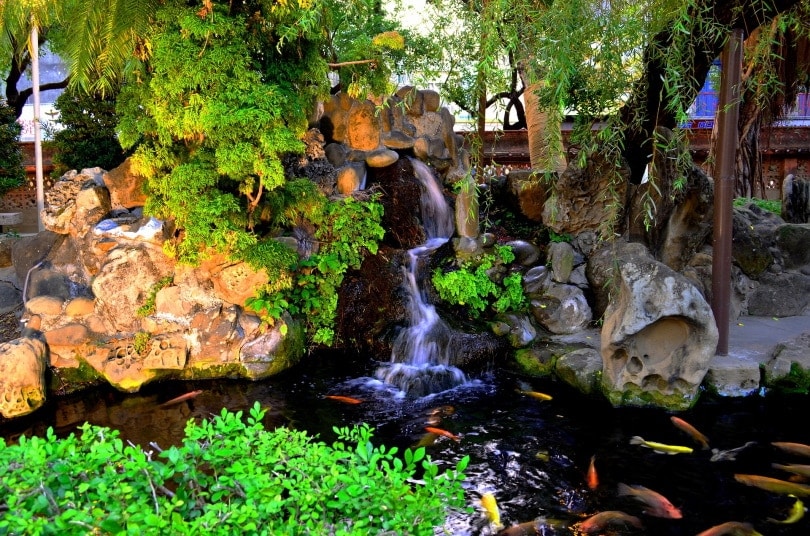Pond upkeep and cleaning can be exhausting! Coming up with ways to clean your pond effectively without draining it and doubling your water bill by having to refill it with hundreds, if not thousands, of gallons of water isn’t just a huge pain either. It’s a time suck and can be a costly investment.
Sometimes, when it comes to pond maintenance, you have to get a little bit creative to come up with ways to keep your pond clean and healthy, without the hassle of draining it every month or two! Read about some great ways below.

The 8 Ways to Clean a Pond Without Draining It
1. Add Plants
The first thing you have to understand about adding plants to your pond is that they are not going to remove solid waste, so you’ll still be responsible for that. However, plants remove chemical waste products, like nitrate, from the water column to use for nutrition. Plants can also help oxygenate the water, making your pond an overall healthier place.

2. Use a Net
The use of something as simple as a pool cleaning net can make a big difference in your pond cleaning schedule. Use a net to remove floating waste in your pond, like leaves, cut grass, trash, dead plants and animals, and anything else you spot floating around. Some of these items can foul the water as they break down, decreasing the water quality and clarity.
3. Vacuum the Bottom
This option does involve removing some of the water from your pond, but it doesn’t have to be a significant amount. Using a pond vacuum from time to time can help remove waste and algae that has settled toward the bottom of the pond, preventing them from fouling the water as they break down. You don’t have to go overboard and vacuum the pond to the effect of a few hundred gallons but doing this task on occasion can make a big difference in maintaining water quality for a longer time.
4. Improve Filtration
Just like in a fish tank, a pond filter pulls chemical and physical waste from the water column. This improves clarity not just through removing physical waste, but also through supporting beneficial bacteria colonies that work to reduce chemical waste products, like ammonia and nitrite. Filtration also keeps the water moving, preventing your pond from becoming stagnant.

5. Improve Aeration
Improving aeration in your pond can be done through filters, water features, and air stones. Aeration increases the dissolved oxygen in the water, improving the health of your pond livestock. It will also help prevent water stagnation, which can be detrimental to beneficial bacteria colonies. Beneficial bacteria need aerated water to thrive, but many types of bad bacteria thrive in stagnant water, which can lead to unpleasant smells and the death of plants and animals.
6. Prevent Algae
The easiest way to get rid of algae is to prevent it in the first place. It can be extremely difficult to get rid of algae blooms, but the addition of plants and adequate filtration can help reduce the risk of algae taking hold. One of the best options available for algae control is UV lights, which can be installed in your pond or in the hoses of your filtration system. UV lighting kills free-floating algae, so it won’t do anything for algae growing on surfaces, but it will help kill off algae blooms.
7. Support the Bacterial Colonies
Supporting your beneficial bacteria colonies can be accomplished by ensuring the water stays aerated and the bacteria have surface areas to colonize, like in filter media and substrate. The other way to support your beneficial bacteria is to use bottled bacteria, especially after your bacteria may have been killed off during a freeze or lack of water movement.

8. Use Water Clarifier
Water clarifiers are chemical additives that help to bind to particles in the water, making them easier to be filtered or vacuumed out. There are some natural options for water clarification, like barley-based products, and other products that are more chemical-based but still safe for use with pond livestock.

Summing Up
The best thing you can do for yourself when it comes to pond cleaning and maintenance is to stay on top of it. You can use any combination of the above ideas, or use all of the above ideas, to keep your pond clean. Make sure you aren’t performing too many cleaning items all at once, though, as this can harm your established pond cycle and bacteria colonies. If you make it a point to perform a cleaning item or two every few weeks, you’ll find that caring for your pond is much easier and more efficient. You’ll have less difficulty with filters and water features and more success with a healthy, attractive pond.
Featured Image Credit: Piqsels
